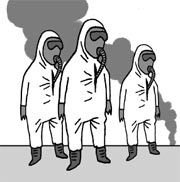The samurai and the Fukushima Fifty

The network of underground bunkers and tunnels became instrumental in the Japanese Army’s resistance against the U.S. forces. The number Japanese casualties was 20,700, while 28,000 American soldiers were killed or injured. The casualties may seem smaller on the Japanese side, but if you look at the number of deaths alone, it becomes a different story. While 6,800 American soldiers were killed, nearly all 20,700 Japanese died. Since surrender is considered a humiliation in Bushido, or “the way of the warrior,” also known as the samurai code of conduct, the Japanese soldiers chose to give their lives in battle.
As the relationship between the feudal lords and vassals became stronger, the samurai code became a virtue. The 17th century book “Hagakure” - a bible for the Samurai - claims that Bushido is a constant reminder of what an honorable death is. It teaches that a samurai must begin a day by meditating about death. Yukio Mishima, a nationalist writer who committed a ritual suicide by disembowelment, was inspired by “Hagakure.”
The samurai’s perspective on life and death is deeply rooted inside the minds of the Japanese. A meaningful death is just as important as how you live your life. The mindset is often exploited by the authorities. Young kamikaze fighters were encouraged to send dive bombers into U.S. warships as a sacrifice for the country.
But if a sacrifice is made to save the lives of others, the death is noble and honorable. Those going into the Fukushima Daiichi nuclear plant reportedly have a chance of dying within two weeks, but the number of volunteers has grown from 50 to 580. It is truly inspiring and moving that they are not reluctant to sacrifice their own lives to save the lives of others.
*The writer is a senior international affairs reporter of the JoongAng Ilbo.
By Nam Jeong-ho










with the Korea JoongAng Daily
To write comments, please log in to one of the accounts.
Standards Board Policy (0/250자)